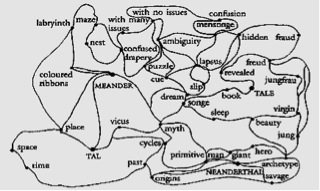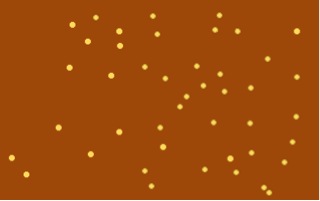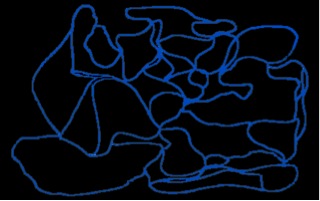The Venues of Process
March 1997
VENUES OF PROCESS:
THE ROAD UNRAVELED
The Changing Form of Exhibition
by musEleanor, C.M.S.A.
ECO’S DRAWING
This 20th century labyrinthine line drawing by Umberto Eco* traces the development of a pun created by James Joyce for Finnegan’s Wake. The drawing illustrates a decoding of the pun, tracing possible nodes of association which link the words “Neanderthal,” “Meander,” and “Tale” from which Joyce formed the transformative word “Meandertale.” The newly constructed word “Meandertale” appears to signify the very name of the process that forms it, a meandering quest for associations between words–a quest where these associations simultaneously tell the story of the words’ evolution and transform them. In such a well-ventilated world, perhaps one necessary constraint might be to assume that no word suffers more than six degrees of separation from any other.
CLUES WITHOUT CONTEXT?
How far astray can the routers of imagination take us from what we can consider true? Can we be sure that such a quest on a well-trodden path is revealing good metaphorical expression? Clues without contexti.e., the names without the lines–make the subject of the drawing cease to resonate its potential; it simply becomes a representation of itself where everything is equal or in a simplistic hierarchy (some are upper case, some are lower). The labyrinthine journey defined by the convoluted node line occurring between words is sprinkled with alchemical events: occurrences in language where two words together form another that leads to a whole new expression of association and meaning. Such events stimulate vernacular, slang and new languages.
MYSTERY WITHOUT [E]MOTION?
Then again, selecting the nodes in Eco’s drawing without their names or connections offers mystery (go ahead, connect the dots)–but the literary metaphor suffers a loss of its muscular tone, its life-like exuberance. As the depiction of convoluted connections disappear in the above drawing, the resonance also falls away, dwindling to nothing. If we absent everything but the line, its function as a pointer to possibilities suffers. We have uniformly subtracted from this path any of its significant elements.
ORDER WITHOUT SIGNIFICANCE?
In the modernist notion of exhibition, the curator and the viewer are sequestered on opposite sides of the proscenium. The curator presents a “story” of the exhibition with a beginning, a middle and an end. An “opening” commences the exhibition, the exhibition period is even and consistently passed, and the “closing” announces the fall of the curtain, case closed, on to the next cultural construction. Documentation is arranged prior to the tenure of the exhibition, usually in the form of a catalogue published simultaneously with the show’s appearance. During the tenure of the exhibition, or shortly thereafter, the show is reviewed by “others”–critics who stand apart as specializing in placing the exhibition in a context . The significance of a link is provoked by the relationship of the material at either end of it. This type of exhibition structure has a kind of pedagogic implication, providing a set piece for drawing conclusions, making comparisons, sustaining a particular set of ciphers constituting what we call culture.
Now we are seeing more and more the appearance of an exhibition venue harboring more intent towards the artist’s process than product. These are opportunities for artists where the relationship of one work to another, whether solo or group exhibition, conjures up additional language in the reader’s mind which makes the leap from one work to another. This invisible text, an emerging hieroglyphic structure in the reader’s mind, is the activity which conjures up a new language of the links and a new mode of presentation. Hypermedia links are pockets, absences, lapses, synapses, indicating what is inexpressible or interactively assumed by the viewer or reader. The subtext of the work can be embedded, even inconsistently, in the linkages and left to the viewer to decipher.
Venues of Process:
There are experiments going on now all over the world–venues offered with open arms to artists where a work can initiate, grow and take on a form that is purely of its own conclusion. These venues of process, of course, are affected by the circumstances and constraints under which they are developed and presented. I will discuss how these venues address the idea of the artist’s process taking place in the exhibition–how each venue forms its own unique environment for process.
BLAST, xaf Foundation
Sandra Gering Gallery, New York –
November 22, 1996–January 4, 1997
In my article in the January issue of IA, I defined the “BLAST” exhibition as an “ever-changing cat’s cradle of collaboration… making history of history making history.” I was referring to the development of the exhibition of works–whether documentary, object, display and/or performance–over the time of the exhibition’s tenure. The designated particular theme (Drama) signaled a call to the artist to develop a new work or adapt an old, or at least to see a pre-existing work in a new context. New works, of course, require time to develop, and there was a time when new works were developed privately, in the studio, and the various stages of their development were neither seen nor discussed. BLAST’s in-depth sweep of good works was enhanced by the fact that all the works were changing over time, whether literally or by perception. Artists were, to different degrees, influenced by their experience of each others’ work. This seems to me to be more than process and/or collaboration–it offers the same kind of alchemic events inherent in Eco’s drawing. Because the more artificial borders between artists are broken down by “interest,” more and more directed possibilities emerge, creating a vibrant theater of operations.
TECHNOSEDUCTION
The Cooper Union for the Advancement of Science and Art,
New York
January 17–February 15, 1997
“TECHNOSEDUCTION” was an art exhibition of very varied technologies and processes. It was based on a discrete and specific “interface”: thoughts of technology and seduction where the seducer and seduced are chameleon-like and transformatively interchangeable. At the exhibition opening, passing trays of food held high in the air echoed the exhibition’s mode of presentation itself–the coinage of a fixed idea handed to viewers on a platter. This appears to be a straightforward ideology. In choosing between process and/or product orientation for an exhibition, one would think the former would be the riskiest. But there is risk in the “platter of objects” mode, too–it hangs on one statement rather than many possible interpretations, and the exhibition may be judged on the nature of the statement rather than on the works itself, even if that is not the intention.
A muse-educated colleague of mine described “TECHNOSEDUCTION” as a “3-ring circus,” meaning that in a derogatory way. I see it as quite noble and brave in the face of current theoretical ground. The circus is exciting and often frightening because of all the possible things that can go wrong in a way that can’t be masked or denied.
The presentation of “TECHNOSEDUCTION” does incur a “representational” aura since its nature tends to make viewers and curators alike break it down into “types of work”: installations, display, interactive interface topography, etc. Perhaps this was intended to show how technology offers many possibilities, and will not homogenize our endeavors. But emphasizing criteria of “visual or physical differences” to define the exhibition undermines its tenor, diminishes its muscular power, takes all the scariness out. This may be secondary to the fact that there were wonderful works in the exhibition and that it was very much worth seeing, but it will be interesting to see how wonderful works sit in the context provided for them from this point on.
PORT
January 25–March 29, 1997
On-line and at The List Visual Arts Center at M.I.T.
http://artnetweb.com/port/
“PORT” of course, is the epitome of real-time risk: a space and time where an artist has the opportunity to develop not only a work, but the process of developing the work itself. The closest analogy I can find to it is the development of a choreography or orchestration where the process is visible to the audience. “PORT” has three stageset space-and-time layers of venue. A live audience–as in physical presence at the location where the work is being made (in the studio etc.)–an online real time presence, and a physical presence at its “destination”–the four screens at the List Visual Arts Center at M.I.T. As muse, I am encouraging this sort of venue for artists–a venue where an idea can be born, tested, evolved, and even revolutionized over a period of time while visible to others, where artists can overlap and collaborate while retaining their individuation (in this case, designated by time slots). “PORT” is an ideal venue because artists can afford to surrender their preconceived belief systems and undergo a wavering, analysis, deconstruction, loss of faith and tossup, up onto a new path. Speaking for one of the artists in the “PORT” exhibition, “It is the closest thing to artists being able to follow Dante’s footsteps through The Inferno in real time.” If any exhibition endeavor has achieved this recently it is the “PORT” exhibition, and its process itself is very apparent and very evident throughout the performative development of the work.
———————
*Diagram by Umberto Eco from The Limits of Interpretation, A Midland Book, Indiana University Press, Bloomington and Indianapolis, 1994, Illustration 9.2, p. 141.
Photo Credits: Variations on Eco’s drawing by musEleanor
© Hyperactive Co. 1997





